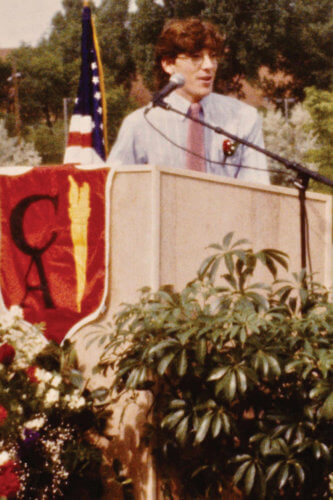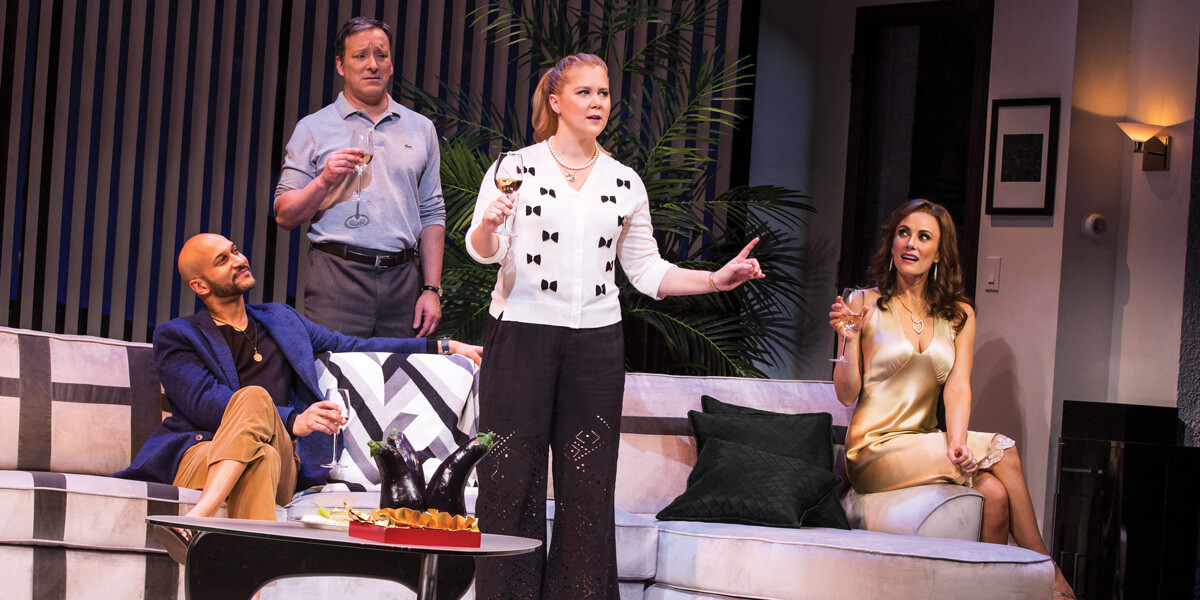
The seeds for a lifetime are sown early in children. All four children of Susan and Jeremy Shamos, (the younger Jeremy ‘88, Sara ‘00, Suki ‘86, and Geoff ’98), attended Colorado Academy from Kindergarten through high school. Jeremy and Susan each served as a Colorado Academy trustee, and they continue to support the school long after their children are gone.
Taught by the likes of CA legends, former Fine and Performing Arts Chair Angel Vigil and the retiring Choral Director Cindy Jordan, the younger Jeremy is now a successful film and stage actor. On stage, Shamos has appeared in 9 Broadway productions, most recently Steve Martin’s new four-character play Meteor Shower with Amy Schumer.
He received a Tony nomination for his performance in Clybourne Park, other Broadway plays include Glengarry Glen Ross with Al Pacino, Noises Off, The Assembled Parties, among others. His more than 20 Off-Broadway performances have garnered him an Obie Award, a Drama Desk award and 2 Lortel Awards.
On TV he played Craig Kettleman on Better Call Saul, Johannes Karlsen in Nurse Jackie and more than 30 guest appearances. In Film, he was smashed on the head as Ralph in the Oscar winning film Birdman, and played George in Magic in the Moonlight with Colin Firth among other films.
The importance of comedy
In a conversation with CA, Shamos recently shared his thoughts on art, education, and the importance of comedy in today’s world.
Colorado Academy: You and your family have an impressive legacy at Colorado Academy: between you and your siblings, there were 24 continuous years of Shamos children attending CA.
Jeremy Shamos: I think the fact that all four of us went to CA, and all loved our time there, and yet we left and pursued four different paths, each of us passionate and curious about our professions, points to what I think is one of the core values of CA. That is to explore everything, take advantage of all the school has to offer, approach everything with an open mind, and follow your passion. I also loved the fact that arts were such a part of the curriculum and everyone found a place where they could explore and excel.
CA: What do you think about when you hear that CA traditions like the Senior-Kindergarten Buddy Program, Giant Relay Day, and other favorites are alive and well at CA?
Jeremy Shamos: I have fond memories of the Senior-Kindergarten Buddies, because when my sister was a Senior, her buddy was my little brother who was in Kindergarten, and when I was a Senior, my little sister was my Kindergarten buddy. It all seemed like destiny. I loved carrying her on my shoulders to assembly, and I loved the feeling that the school was a big family.
CA: Many of the roles you have played have been in comedies. The late Robin Williams is quoted as having said, “Comedy is acting out optimism.” Is that part of the motivation behind your life as an actor?
Jeremy Shamos: I think there is something to be said about the idea that the purest form of hope is art….Often, art is the most direct way for the next generation to reflect new views on reality. Young artists can infuse the world with new perspectives. At its best, art can rearrange perspectives, and with mass media, the possibility to change viewpoints is there.
CA: And what about the role of comedy in this current time in our country?
Jeremy Shamos: If people stop laughing, we are doomed.
CA: When children experience the arts from a young age, whether as an audience member, a patron, or an artist themselves, what are the skills that they develop and carry for a lifetime?
Jeremy Shamos: I can speak for myself that my experience at CA was a perfect balance of two seeming opposites: respectfully nurturing my individuality and teaching me that you must work with others to accomplish great things. That was taught in many ways: shared projects in all subjects: partner and group experiments in science classes, English classes held at tables where everyone’s opinions are bandied about and heard, combined with the usual papers and individual projects that one would expect from a great school. The great sports teams that we had, and the fact that sports were required, was a huge part of learning to work together. I work with so many artists who were forced to choose between their art and sports at an early age; their schools were big enough that if you wanted to be in the play there was no way you could also play soccer. I got to be in the plays and musicals and at the same time play Varsity Soccer and Lacrosse. The school worked to make this possible, and when I left school, I realized how rare my experience was. At many schools there are “jocks” and “theater people,” etc…. I got to do everything and am a more rounded person as a result.
CA: The school is working to generate the funding to build a new theater on campus. Thoughts?
Jeremy Shamos: I can think of few things more important to give to kids who are already privileged enough to go to CA than a place for them to work together to create art and be in touch with the creative parts of themselves.
For me, I found out early that I loved the theater, and I feel so lucky that I got to do Middle and Upper School plays and musicals. I think people who aren’t in the theater underestimate what it means to have a “space” where you know you can be creative. When I was at school there was a choir room, an art room, a photo lab, a dance room in the gym, and of course Froelicher Theatre. The arts were supported, and a big part of that support came not only in the courses and programs that were offered and the incredible faculty who nurtured our budding artistic abilities and interests, but it was particularly reflected in the infrastructure. We had this big campus and the arts buildings were just as prominent as the gym and the fields. This sets a tone and shows a prioritization that served me so well as I left CA. There was no doubt in my mind that the arts are not only respectable professions, but they are important professions.
CA: With the availability of technology these days, what do we stand to lose if we don’t keep live theater alive?
Jeremy Shamos: There is something tribal and deeply human about telling stories by acting them out live. There is no doubt that no film or television show or even hologram can replace breathing the same air with performers. The more technology helps us, it also has the ability to isolate and dehumanize us.
CA: How have you shared the world of art with your own children?
Jeremy Shamos: I feel lucky to live in New York, because my children are exposed to visual art and music and theater a lot. They also go to a school where art is valued and is a big part of the curriculum, which was important for my wife and me when selecting a school for them. I used CA as a model for what I wanted for my kids: a place where they can follow their interests and be supported in that, but also a place that encouraged and required them to go outside of their comfort zones.
CA: What are you working on right now?
Jeremy Shamos: I am working on a new film with Hugh Jackman and Allison Janney, two of my favorite actors, and a really interesting film. It shoots here in New York, so I get to spend my days off with my wife and two kids in Brooklyn. I’m looking at various plays in the spring. I feel really lucky to be in the place I am in my career where I can work on projects that I care about and have lots of time to be the dad and husband that I want to be at the same time.
